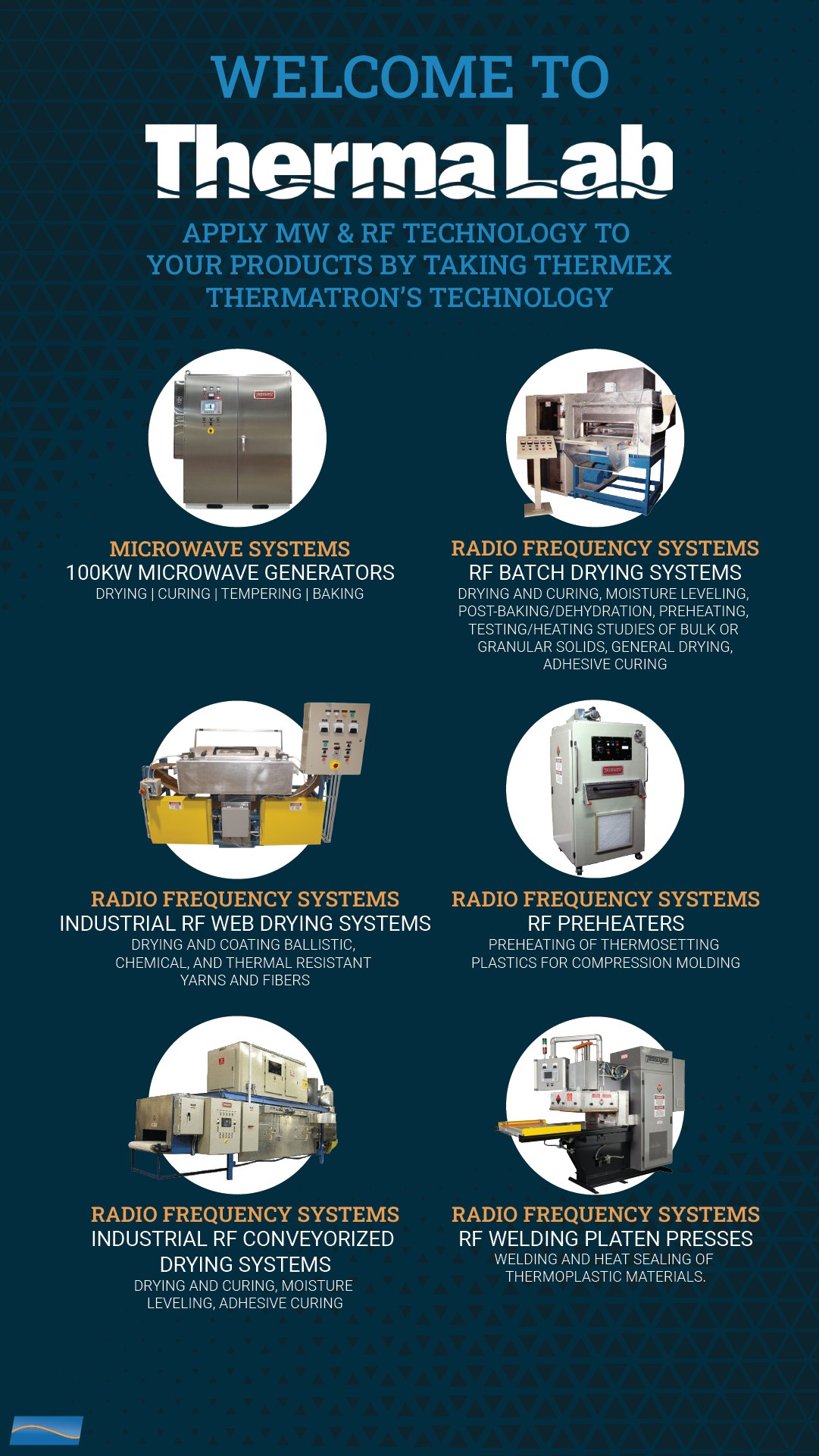Commercial Microwave Ovens for Industrial Applications
Thermex-Thermatron Systems
A leader in the industry, Thermex-Thermatron serves manufacturers around the globe to enhance their microwave (MW), radio frequency (RF), and thermal technology systems.
Bringing over 80 years of expertise, they have developed many new products over the years to assist customers with their manufacturing processes. Thermex-Thermatron's in-house laboratory "Thermalab" allows clients to experience firsthand how microwave and/or radio frequency heating will benefit their products.

Commercial vs. Industrial Microwave Ovens
There is a significant difference between a commercial microwave oven and an industrial microwave oven. While commercial microwave ovens are designed to be inexpensive to assemble and easy to operate, their effectiveness is limited when compared to an industrial microwave applicator and generator combination. Designed to evenly and efficiently apply energy to a certain type of product for a specific purpose, many are considering commercial microwave ovens as interest in green heating technology increases.
Home and Commercial Microwave Ovens
Known as a multi-mode cavity, a home or commercial microwave oven is the most basic type of microwave oven. Referring to the electrical ‘size’ of the oven chamber compared to the physical wavelength of the microwave energy used, the energy is dumped into the oven’s chamber directly from the magnetron by way of a single port.
Typically operating at 2450 MHz, home, commercial, and institutional microwave systems control ‘power’ by applying energy over time using a duty cycle. The microwave turns the power on and off in bursts of varying duration (higher power equals longer on-times). The object to be heated may or may not be rotated within the chamber to minimize the effect of naturally occurring hot and cold spots resulting from standing waves. Since many objects cannot tolerate even short bursts of full power this control method has limitations not found in true industrial equipment.
Batch type systems, home / restaurant & commercial microwaves do now allow objects to be added or removed from the microwave system while the microwave energy is on. This makes them unsuitable for industrial microwave applications as they are a continuous processing application and require an uninterrupted flow.
Industrial Microwave Ovens and Generators
A ‘low end’ multi-mode industrial microwave applicator and generator typically has the following features:
- Two ports that bring microwave energy into the applicator.
- A rotating antenna, or mode stirrer, that evenly distributes microwave energy throughout the applicator.
- Continuous power control from low to full power.
- A circulator to prevent microwave energy not absorbed by the process from reflecting back and damaging the magnetron. This would occur near the completion of the drying or curing process. (These are rarely found in commercial microwave ovens due to the benefit-cost ratio of the equipment.)
- Choice of operating frequency of 915 MHz or 2450 MHz. (This would be contingent on power required and best performance characteristics.)

Industrial microwave applicators can take other forms for specialized uses, such as:
- Traveling wave applicators for liquids, gels, etc.
- Single mode (resonant) applicators for plasma generation or applications requiring very high power density.
- Leaky waveguide applicators for ovens requiring even heating of large masses.
- Serpentine or slotted line applicators for thin materials.
- Industrial microwave applicators are easily moved, allowing continuous product flow for uninterrupted production.
- Applicators can be equipped with hot air systems, humidity control, and inert or special atmospheres to allow for controlled environments.

What Is an Initial Heating Ability Test and How Is It Performed?
An initial heating ability test is a quick test that answers the question ‘“Will it heat?” To conduct a heating ability test, place the object in a home or commercial microwave oven and run a short cycle (typically less than one minute), before checking the object’s temperature. A small container of water should always be placed in the oven during testing to guard against oven damage.
If the heating ability test is successful, you should then discuss your material, material handling, and process requirements with a qualified microwave designer to help you determine what type of industrial microwave applicator and generator combination is right for the job. Oftentimes when the initial heating trial is promising, an attempt is made to use a commercial microwave oven such as those designed for restaurant or institutional use. More often than not, this approach is unsuccessful. The reason for this is not due to the microwaves themselves but how they are applied to the work.
For Thermex and Thermatron inquiries, contact our Director of Sales, Dean Mancuso (Sales@thermex-thermatron.com; 502/916-8972 or 502/243-5636).
For FIAB and Oteman inquiries, contact our Director of Business Development, Traci Evling (Traci@thermex-thermatron.com; 502/916-8981 or 904/662-2169).

